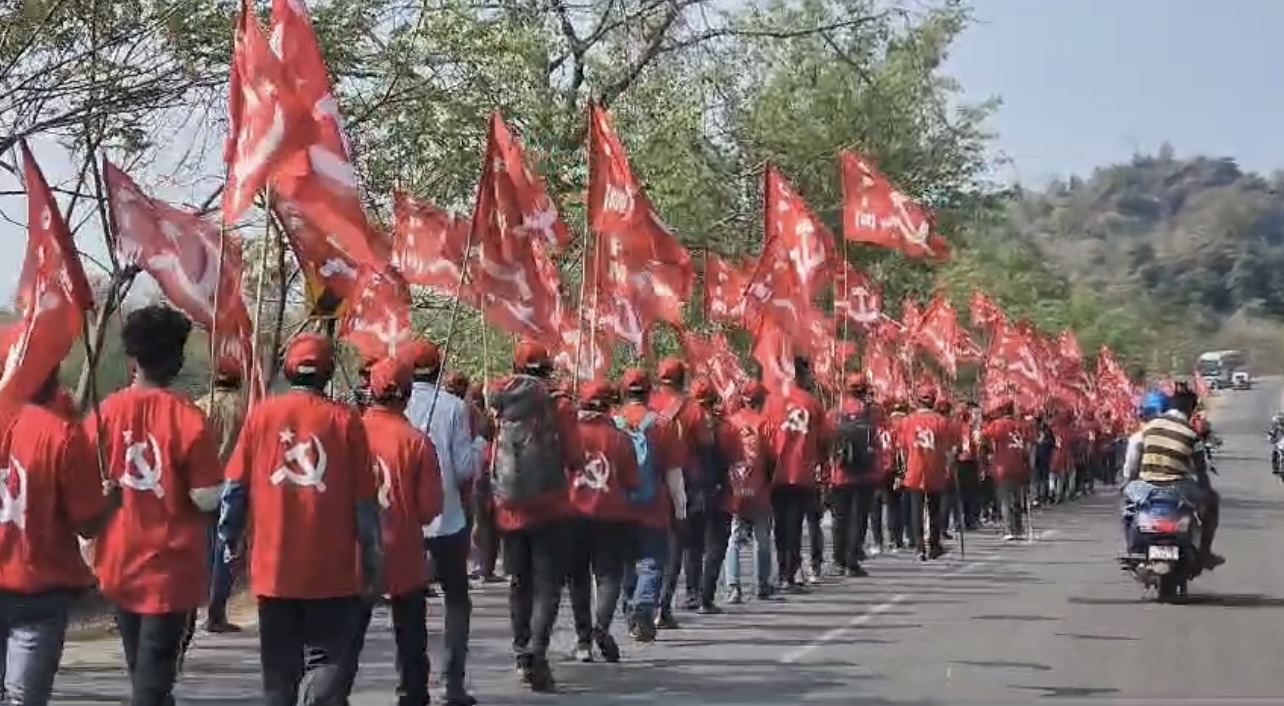- Odisha plans to restart bauxite mining on the Mali hill in Koraput district but is facing resistance from local residents.
- This resistance has been ongoing for two decades. Environment Clearance for mining on the hill was granted in 2006 but the project stopped functioning after 2014-15.
- Bauxite mined from this region would be sent to Uttar Pradesh, Jharkhand and Karnataka for industrial purposes. Villagers allege that mining can lead to drying of 36 identified natural streams, pollution and affect the natural irrigation of farms around the hill.
Early last month, a notice was sent out from a local police station to some of the residents from 51 villages around the Mali Parbat, a hill in the Koraput district of Odisha. The notice, in English, to the primarily tribal district, accused the people of conspiring to disrupt an upcoming meeting of the gram sabha (village council). The meeting, to be held on November 22, had been proposed to seek the consent of the villagers for a bauxite mining project, a much-contested topic for almost two decades.
The accused were summoned to the police station and were detained by the local police to prevent them from attending the village council meeting, the villagers told Mongabay-India during a visit. Meanwhile, 20 police platoons were deployed at the meeting site to avoid any disruptions, indicate media reports, and barbed-wire barricades were set up near the site. People in the vicinity, as far as three kilometres from the meeting site, were scrutinised and some, even not on the suspected list, were not allowed to attend the meeting.
The meeting was for the Mali Parbat (Mali Hill) mining project that is proposed to come up over 268.11 hectares of this hill. There has been ongoing resistance by the tribal and non-tribal rural population in the affected villages around the hill since 2003, when the Environment Impact Assessment, required for obtaining clearance to mine the hill area for bauxite, had started.
In the most recent of objections, the gram sabha meeting on September 22, 2021, witnessed disruptions with chairs at the site being damaged and clashes between the administration and local residents who made accusations about starting the hearing before time, which left out those who showed up on time. The protestors were arrested and the September meeting was cancelled. Then, more recently, before the November 22 meeting, several women protesters from the affected villages gheraoed the office of the Collector in Koraput to protest against the alleged government role in the bauxite mining matter. These incidents led to closer surveillance of the November meeting, with the police pre-emptively preventing people that they suspected of disruption, from entering.
Following the meeting, Rajendra Pujari, Additional District Magistrate, while speaking to the local media about the cooperation of the people, declared that the November 22 gram sabha meeting was peaceful and was a success. The decision and discussions of the meeting would be sent to the union Ministry of Environment, Forests and Climate Change for consideration with regards to the environment clearance (EC) for the mining project.

The villagers, however, claimed that many of them were denied entry into the meeting while several of them were detained on their way to the site. “While I was going to the gram sabha meeting, I was stopped and denied entry. Along with some other women, I was taken to the local police station and we were asked to sign on a blank paper. We were released after about five hours of detention,” Manima Patnaik, a resident of Aligaon village (in Koraput), which is one of the villages affected by upcoming bauxite mining, close to the Mali Parbat, told Mongabay-India. She said that her name was not even in the list of 51 people who were issued a notice by the police accusing them of a conspiracy before the hearing.
Nanu Pujari, another woman from the village said that she along with 14 others were taken in a bus and were dropped five kilometres away from the site to prevent them from attending the meeting. This was in addition to the detention and arrests of other male members of several villages around the project site.
Villagers claim that around 15,000 villages from 42 villagers around the site were going to be affected, but the meeting was held with less than 300 members due to the pandemic. However, this is against the September 2020 order of the Ministry of Environment, Forests and Climate Change which had even advocated for scattered meetings, written consents, electronic outreach and other means during the time of COVID-19 to ensure widespread consent in mining-affected areas.
What is the mining project proposing?
Bauxite mining has been proposed on the Mali hills. Government documents, including the 2006 Environment Clearance given for mining in the area, claim the land is barren. However, while visiting the area, Mongabay-India observed that the hill was full of trees and green vegetation, except for the hill top which was rocky and didn’t have any vegetation.
Aligaon is a village at the foothills of the Mali Parbat and in addition to it, villages in and around the proposed mining site, are against the project and claim that it will threaten the local environment, besides hampering the 36-odd water streams that emerge from the hills and supply water for irrigation use in several farms.
Parsu Pujari, a farmer from Aligaon said, “We have been living in the villages for several years. There is a large tribal population in the area around the village and many villages are likely to get affected if mining starts here. There are many water streams that come out from the hills which are used in irrigating our land. If mining starts, there will be a rise in pollution levels in the otherwise serene and green area.”
Dashrath Japuria, another tribal person from the village said that the tribal communities revere the hill. The sacred cave Pakuli Debi on the hill is connected to their faith. Any devastation of the hills due to mining would go against their faith and hurt sentiments.
People from other villages, such as Arjun Kirsani from Kokariguda village in Doliaguda panchayat, claimed that the police used a large force to instil fear in the villagers that would in turn make them vote in support of the mining plan. They say they believe the meeting was orchestrated by the local administration to ensure support to the mining project.
Sankar Prasad Pani, environmentalist and lawyer at the National Green Tribunal (NGT), questioned the way in which the meeting was conducted.
“The large deployment of force in the gram sabha meetings affects the free and fair conduct of such meetings without fear in mind. This diluted the very concept of free consent for any project in scheduled areas as mentioned in the law books,” Pani told Mongabay-India.
However, the fears and apprehensions of villagers are not without a reason. The Environment Impact Assessment (EIA) report of the mining project also speaks about the likely threat from the operations of the bauxite mining as the project is likely to see drilling, blasting, transportation and other activities.
The EIA report claims that 40 percent of the mining operations would be done through drilling and blasting which is likely to degrade 109 hectares of the land at the site from the total of 268.11 hectares of land required for the project. The report also talks about the likely chance of wash-off from the waste during mining and transportation during monsoons. It had claimed that noise levels at the nearest habitation (Pagugurha village) is likely to see an increase up to 1d(B)A due to the mining work. It said some streams originate on the top of the plateau and flow down to the hills to unite to other second streams.
The EIA report also talks about several measures that could be taken to counter or reduce the negative impacts of the effects on the local environment and communities.
Long running resistance
The mining company was granted the surface right of lease in 2007. The mining in the area operated for a brief period after 2012 where it faced resistance as well as support from the local people. Clashes broke out between the two opposing groups several times. Soon, the mining operations were stopped and then, in March 2019, the lease expired.

The gram sabha meeting last month, on November 22, was organised to seek consent from the villagers to renew the mining project. But with the deployment of police force and detention of people, the meeting is now marred by controversy.
In the 2000s, a local outfit, Mali Parbat Surakhya Samiti was also formed to spearhead the movement against mining. Local activist Prafulla Samantara had also moved the National Environment Appellate Authority (NEAA) against the environment clearance given for the mining in 2006 but the NEAA rejected the plea citing delay in approaching the authority.
Samantara has other issues to raise too. “In the early 2000s government reports claimed there was no water stream in the hills but in the latest EIA it admits some water sources but denied it being perennial. We personally have seen around 32 such water streams and dense trees on most parts of the hills which the government denies to admit. As the miner failed to start production in the first five years after getting EC, their EC expired in 2011 but it did mining after 2011 under the noose of the same government,” Samantara told Mongabay-India.
Samantara’s allegations also find place in official documents too. According to the latest Terms of Reference (ToR) issued by the Ministry of Forest and Environment, the miner’s plea in 2020 for the same was rejected on September 24, 2020 citing operations of the mining after 2011 without a valid Environment Clearance (EC). It was later revised after more paperwork. The latest ToR was issued by the ministry on February 8, 2021.
Following that, a case was filed in the Odisha High Court in 2008 by a villager from the affected area. The case was admitted but, so far, no significant hearing has taken place in the court.
Why is bauxite important for Koraput?
According to the Odisha government’s Economic Survey, the state produces 51 percent of India’s bauxite and it occupies 76.52 percent of the total minerals excavated in the state. Odisha is the largest producer of bauxite in the country with estimated 154.84 metric tonnes production recorded in 2019-20. The revenue and production of bauxite is only expected to increase in the state as the state plans to scale up the production even more.
According to the mining project plan of the bauxite mining at Koraput, the bauxite mined from the site would be taken to Renukoot in Uttar Pradesh, Muri in Jharkhand and Belgaum in Karnataka and some amount would be used within the state. The Dumriput railway siding, about 25 kilometres from the mining site, will be used to transport the bauxite ore from Koraput to different parts of the country.
The majority of the bauxite reserves in the state is located in Koraput and Sundargarh districts. The district survey report of Koraput, which talks about lush green hills, claims that around Rs. seven crore (Rs. 70 million) is collected by the district administration as royalties from one bauxite mining project alone. The proposed mining projects from the area are likely to further add to the revenues of the state.
But even as the minerals in the district are going to result in more revenues for the administration, it has not resulted in development for the mining-affected villagers. For instance, the area is still not covered with proper pucca (permanent) roads and the rate of unemployment in the area is high. In fact, a recent NITI Aayog report claims that 51 percent of Koraput is under poverty as per the National Multidimensional Poverty Index (MPI).
Koraput Collector, Abdaal M Akhtar and Koraput Superintendent of Police (SP) did not respond to phone calls, emails or messages sent to them seeking their views on the issue.
Banner image: A tribal woman at Aligaon walks in her village near Mali Parbat. Photo by Manish Kumar/Mongabay.









